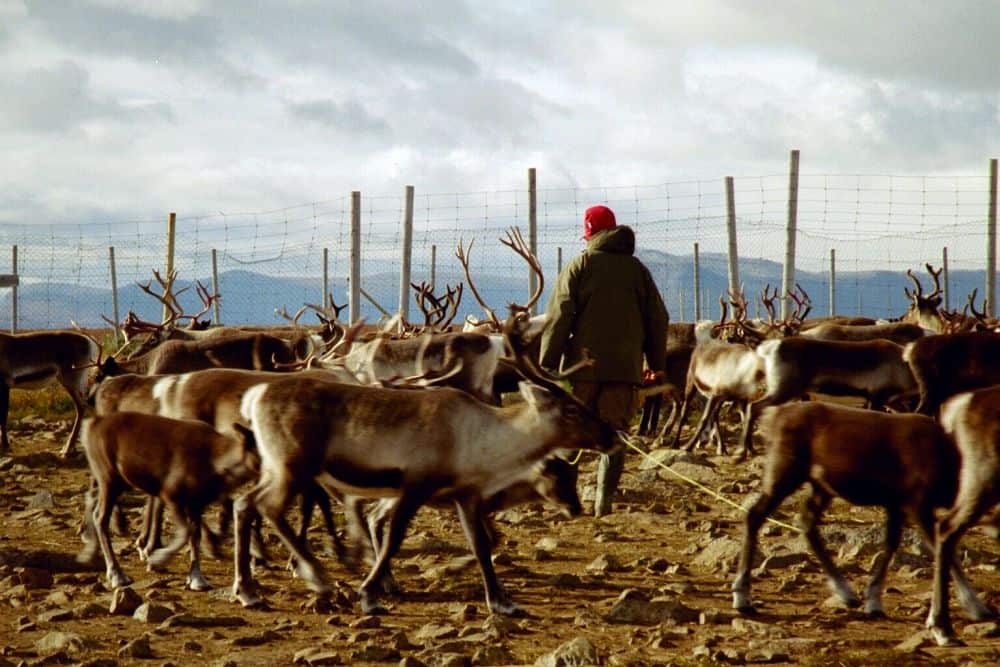
[Image above] A Sámi reindeer herder in Sweden. Mining in Sweden has had a profound effect on Sámi reindeer herding communities, and the discovery of a new rare earth oxides deposit has made the Sámi people concerned. Credit: Mats Andersson, Flickr (CC BY 2.0)
With relations between China and the United States increasingly strained, the desire to identify rare earth resources outside of China continues to grow.
This January, Swedish state-owned mining company LKAB made the striking announcement that it had identified more than 1 million tonnes of rare earth oxides near the town of Kiruna in northern Sweden. This discovery is the largest known such deposit in Europe, and many news articles have debated the impact this deposit may have on reducing reliance on China.
But these articles often gloss over why LKAB believes it will take 10–15 years to secure the required permits and begin mining the deposit. Namely, its impact on Kiruna residents and the indigenous Sámi people.
The Sámi are a Finno-Ugric-speaking people who inhabit the region of Sápmi, which today encompasses large northern parts of Norway, Sweden, Finland, and the Murmansk Oblast of Russia. While traditional Sámi livelihoods include fishing, gathering, handicrafts, and hunting, what they are most well known for is reindeer herding.
Traditional herding was based around the natural migration path of reindeer, but Sámi reindeer herding communities were forced into settlement by the colonial acts of the Swedish, Russian, and Finnish nation-states. Now, reindeer are herded into different winter and summer pastures based on the herders’ knowledge about food resources, climate, winds, and forest structure.
A community of Sámi reindeer herders lives near Kiruna, and their herding of the reindeer is already being disrupted by an iron ore mine that LKAB operates in the area. The Kiruna mine is the largest underground iron ore mine in the world, and its continued expansion—along with growth in the town of Kiruna—has created a bottleneck for the Sámi herders.
“Reindeer up until 1948 trekked through Kiruna in a path [Sámi reindeer herder Tomas Kuhmunen] described as a bloodline access to pastures,” an EUobserver article explains. “That path has been closed due to the mine and other infrastructure, including an airstrip … As the mine and town expands, it further squeezes an already narrow strip of the district for the reindeer to herd and graze.”
The Sámi herders are unable to bypass the bottleneck because the two neighboring districts will not allow the herders to graze on their land. Additionally, a Kiruna sewage treatment facility pumps out warm water into a nearby creek, which keeps it from freezing over in winter and makes passage more difficult.
The expansion of the iron ore mine has also caused subsidence in the surrounding area. This caving in of the ground puts the town of Kiruna at risk, and about 6,000 people are moving themselves—and some historic buildings—about three kilometers east to avoid the town being swallowed by the sinking land.
Based on this history, the Sámi herders do not feel comforted by LKAB’s promise to conduct fossil-free extraction of the newly discovered rare earth oxides.
“They [LKAB] don’t see the whole landscape in the same manner that we do when we’re herding our reindeers. And that is of course a major problem,” says Sámi reindeer herder Tomas Kuhmunen in the EUobserver article. “They see this as an island, in a vast ocean of nothingness. They see it as fragmented.”
While concrete plans for mining the new rare earths deposit are still a ways off, plans to mine some unexploited iron ore deposits in nearby Jokkmokk are more immediately concerning to the Sámi community. The video below by BBC World Service interviews both Sámi reindeer herders and mining industry representatives to hear their perspectives on this controversial project.

Credit: BBC World Service, YouTube
Author
Lisa McDonald
CTT Categories
- Market Insights

